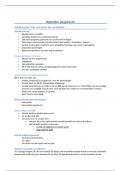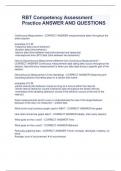(Evaluating Interventions in Patients with Chronic Disease & Psychological Assessment
and Interventions in Chronic Disease)
Lecture 1 – Introduction ............................................................................................................ 2
Lecture 2 – Coronary Heart Disease ........................................................................................ 7
Lecture 3 – Chronic Pain ........................................................................................................ 11
Lecture 4 – Rheumatic Diseases.............................................................................................. 18
Lecture 5 – Psycho-oncology .................................................................................................. 24
Lecture 6 – Diabetes ................................................................................................................ 29
Lecture 7 – Genetic Counselling ............................................................................................. 34
, Lecture 1 – Psychosocial and biomedical aspects of chronic illness and disability
Introduction to the topic of chronic disease
Chronic somatic diseases are noncontagious long-term conditions which can often be
controlled but generally not cured by medications or prevented by vaccinations. Long term
condition: e.g., > 6 months. It is important to focus on this topic, because globally, more than
50% of deaths are due to chronic diseases.
A lot of people suffering from chronic disease experience trouble with adjusting, for example.
This is one of the many things a psychologist could be involved.
The at-risk populations for chronic disease consist of people that engage in risky health
behaviors (e.g., smoking), elderly, females, people that also have psychopathology, certain
personality profiles, maladaptive coping styles, and dysregulated neuroendocrine and/or
immunological system function.
50% of elderly report to have chronic illness. Mostly osteoarthritis (bone disease) and CHD.
Stoke and cancer are the least common in the elderly population.
Chronic diseases have both genetic and modifiable risk factors. Modifiable risk factors are
even more important if genetic risk factors are already present. Lifestyle and genetic factors
also interact.
The rise of chronic diseases has been driven by several behavioral risk factors (WHO):
sedentary lifestyles/physical inactivity, unhealthy diet/obesity, tobacco use. Biological risk
factors: high blood pressure, high cholesterol, overweight.
There are several interventions that significantly impact the course of common diseases. For
example, decreasing tobacco use, losing weight, acquiring a healthy diet, exercising regularly.
Not many people adhere to lifestyle advice. Psychologists can play a role in improving this.
The level of disability is dependent on the severity of the disease and the course of the
symptoms. Also, the manageability of the disease and the threat it represents plays a role.
There are many other factors that influence the level of disability and how you cope with it:
• Acute vs. chronic symptoms;
• Stable vs. progressive;
• Episodic (sometimes a lot of symptoms, sometimes only a few);
• Remission.
There are many different consequences of chronic illness. For example, a change in body
integrity and comfort (less trust in your body & health), change in mental and physical
wellbeing, changes in the concept of self, potential loss of control, change in goals and plans,
change in your social network and relationships, loss of independence, financial instability.
2
,Emotional reactions to the chronic illness and disability could be: grief (reaction to e.g.,
losing control or goals), fear and anxiety (facing threats), anger (frustration, blaming self),
depression (hopelessness), guilt.
Psychosocial factors in chronic illness and disability:
• (In)visible disabilities: for example, stigmatization (individual feelings of shame due
to disapproval of others);
• Body image: mental view of own body;
• Sexuality: physical or mental limitations/barriers.
Adjustment to the illness can go very well, but it depends on different factors. E.g., personal
factors and resources, social support (fulfilling), SES (finances), cultural aspects, activities,
goals, developmental stage (childhood, adulthood, elderly), and your environment. Each
individual needs to be considered in the context of all these aspects before you treat them.
Mean quality of life scores differs per disease. On average QoL is lowest for stroke according
to the study mentioned in the lecture. It is important to assess the consequences of the disease
on a personal level.
The role of a health or medical psychologist could be: giving advice (lectures, discussions),
preventing (lifestyle changes), or treating patients. In the clinical field, you could address
barriers for healthy behaviors (e.g., adherence to medication), you try to facilitate coping with
the disease or help with adjustment, or you could address/treat psychosocial problems
associated with the chronic disease. In research, you study chronic disease at group level.
Then, again you would define barriers for healthy behaviors, but also study mechanisms of
psychological adjustment to or treatment with chronic diseases, and examine psychosocial
factors associated with a chronic disease.
As a health care professional (both career paths), you should:
• Understand the biomedical aspects of the chronic illness or disability → this
understanding facilitates the ability to achieve optimal functional capacity;
• Get insight in the individual’s and societal perception of their condition;
• Understand the individual strengths, resources and abilities;
• Understand personal factors, activities, social and physical environment → assess
how condition affects daily life.
Biopsychosocial model (doesn’t work in clinical practice according to lecturer!)
Roles differ based on treatment situation:
• Biomedical model: the physician is the expert and actively treats an illness and its
symptoms, client is more passive;
• Psychosocial model: the therapist is a coach; client has to actively work on e.g.
coping strategies and lifestyle changes: both have to work actively.
3
, So, a disease is caused by an imbalance of biological, psychological, and/or sociological
factors. The imbalance affects other domains too, e.g., if there’s a psychological problem, this
could also cause biological problems. Each factor is influencing the other. You can also
address one of the factors, and in turn heal the other factors (interventions targeting 1 domain
will affect all the domains).
The model means:
• A change in one domain necessarily leads to a change in another domain;
• More knowledge of interaction of factors can lead to improved diagnoses;
• A single factor is most likely an inadequate explanation, you need to understand all of
the factors;
• Interventions involving more/all elements will do better than treatments based on a
single domain.
Physicians and clients usually have a dominant view of biomedical models, whereas
psychologists have a dominant view of psychosocial models. The current challenge is to
integrate biomedical and psychosocial factors in explaining and treating chronic illness.
4










